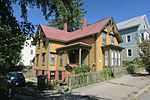North Burial Ground
1700 establishments in Rhode IslandBuildings and structures in Providence, Rhode IslandCemeteries in Rhode IslandCemeteries on the National Register of Historic Places in Rhode IslandNational Register of Historic Places in Providence, Rhode Island

The North Burial Ground is a 110-acre (0.45 km2) cemetery in Providence, Rhode Island dating to 1700, the first public cemetery in Providence. It is located north of downtown Providence, bounded by North Main Street, Branch Avenue, the Moshassuck River, and Cemetery Street. Its main entrance is at the junction of Branch and North Main. The burial ground is one of the larger municipal cemeteries in Southern New England, and it accepts 220 to 225 burials per year.
Excerpt from the Wikipedia article North Burial Ground (License: CC BY-SA 3.0, Authors, Images).North Burial Ground
Branch Avenue, Providence
Geographical coordinates (GPS) Address Nearby Places Show on map
Geographical coordinates (GPS)
| Latitude | Longitude |
|---|---|
| N 41.842777777778 ° | E -71.408055555556 ° |
Address
Branch Avenue 21
02904 Providence
Rhode Island, United States
Open on Google Maps











